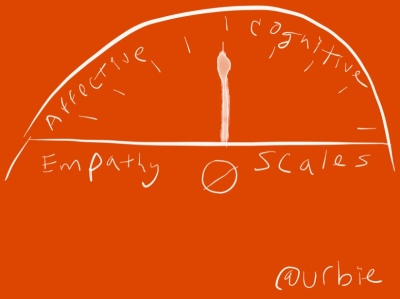PROLOGUE
"How high?"
EMPATHY
In her latest Learning Rebels blogs post @stipton writes Look up! How high? Up to the blue sky? Or is it enough to look around me, into the tired eyes of the other zombie workers? I think she's talking about the tendency many of us have to be so immersed in our work that our days rush by without us. There are at least two reasons for this. One, we fear falling behind and getting replaced by someone who can keep up. Two, our jobs are so satisfying we're in flow from that first sip of coffee until.. when? I don't believe it's flow. I think it has something to do with empathy and the systems we work in.
SCALES
Simon Bernard-Cohen, explaining Empathizing-Systemizing (E-S) Theory describes five brain types. Two of these, E (Empathizing) and S (Systemizing), are of interest to me as I learn more about designing transformational learning experiences. Empathizing is the ability to feel what others are feeling. Systemizing is the ability to analyze and construct systems. I wonder if when we construct learning systems and training, particularly in online modalities, we give enough consideration of learners' feelings about that learning?
I learned that empathy has two scales: affective and cognitive. Cognitive empathy leans towards systemizing. In a recent Google Hangout I tried, I think unsuccessfully, to make the point that it's possible for instructional designers to scale empathy by producing learning experiences that:
- Have learners spending less time sitting in front of a computer
- Use story as hooks to engage learners more deeply
- Encourage learners to make artifacts that visually evidence they "get it"
 |
| Empathy Scales |
In a traditional face-to-face classroom I think most teachers can sense what their students are feeling. I have met a number of teachers recently who leverage empathy to get students moving.
Kinesthetics are the missing piece in online learning, especially when that learning takes place 1:1 (computer:learner). There's so much more to learn and prototype about that.
EPILOGUE
Getting back to @stipton's Look Up! While you're up there, ask yourself: What has you working long and hard: worry or flow? The cartoon in Look Up! has someone observing two others pushing a cart with square wheels. To the observer the problem is the wheels. They could expend much less effort if the cart had round wheels, like the one the observer is holding. But from my perspective it's the two pushing who are in flow. Maybe if the observer made the effort to empathize with them the cart would have round wheels sooner rather than later.

Urbie - Interesting perspective on my post. I very much like the "Empathizing-Systemizing (E-S) Theory" you bring up. I have strong beliefs that we, as L&D, do not take enough time to understand the end user of the product created, whether it be a course or a learning aid. That is, of course, part of "Looking Up" - Look up and understand what is around you, how your actions are effecting others. I'm glad that you took the opportunity to expand on my "Looking Up" thoughts. My point of view with the post was simple, we get too immersed in life and work to see the world evolving without us. We get too comfortable in the work we do and forget it is no longer 1990, and we should be adapting to bring effectiveness, performance support and innovation into the workplace. What is happening around you? The first step toward change is awareness. And as for the cartoon, the first step is for the two pushing the cart to become aware they have square, ineffective wheels. And unfortunately, a lot of times this is where L&D sits, with square wheels, while those around them are trying to show them they need round wheels. This is the attitude/behavior from which L&D need to "Look Up". Again, thanks for bringing a different perspective to the the post!
ReplyDelete